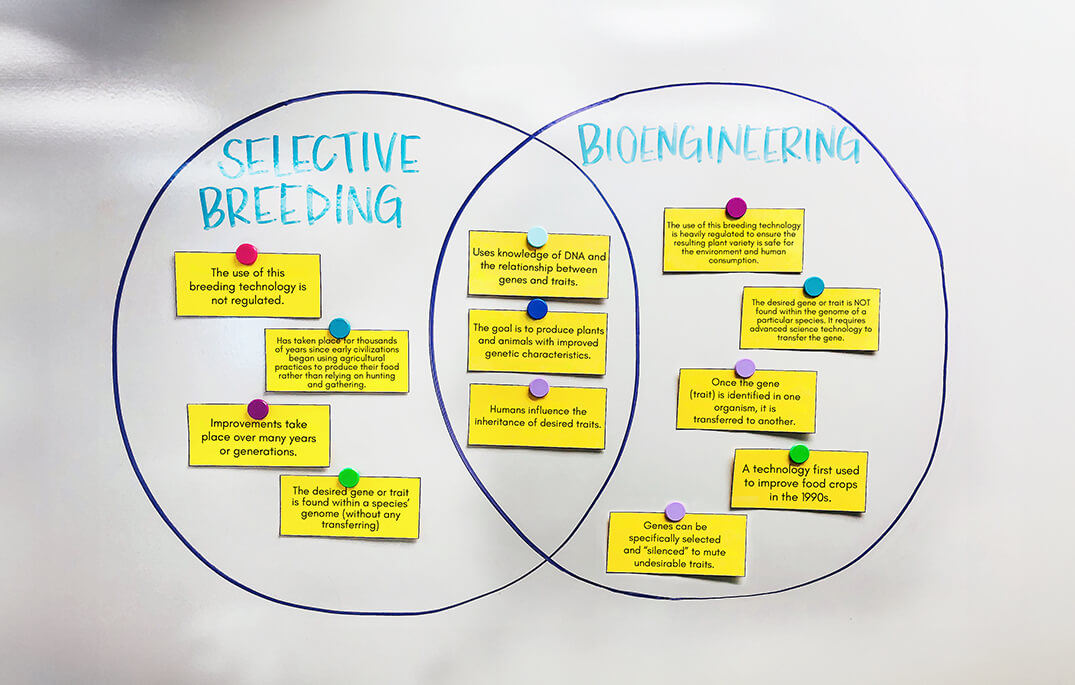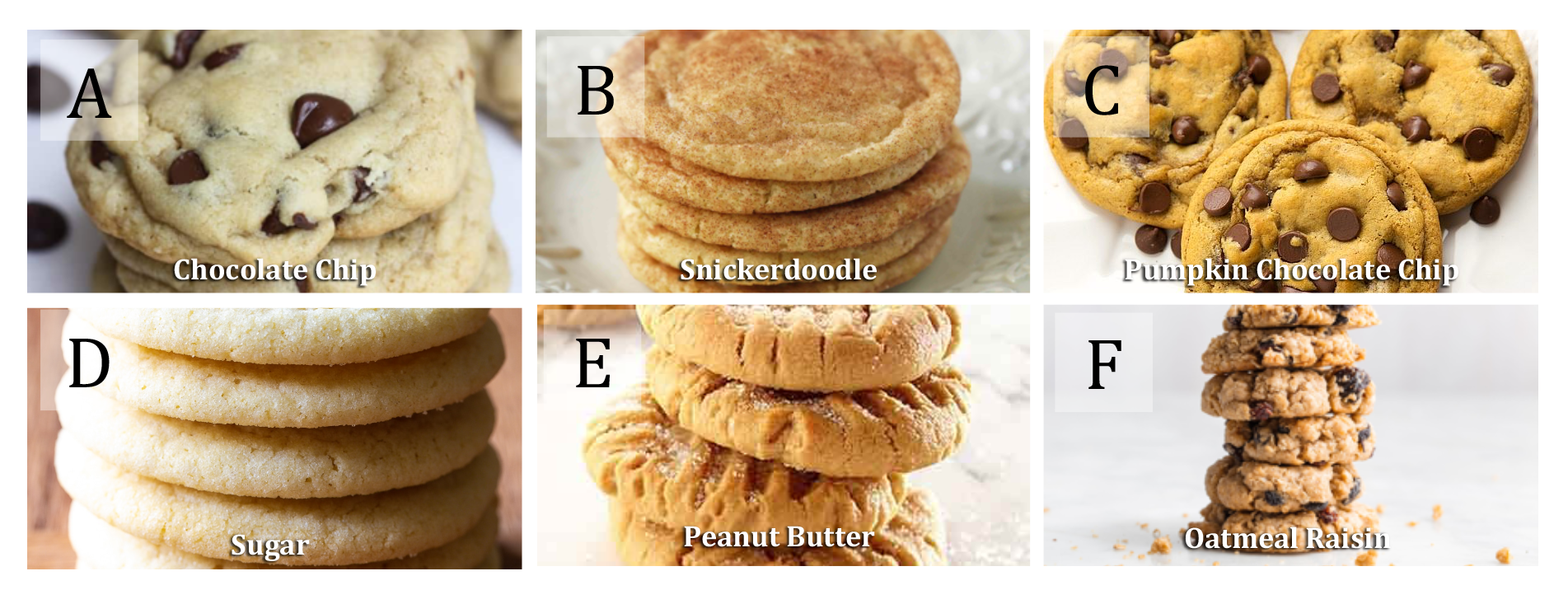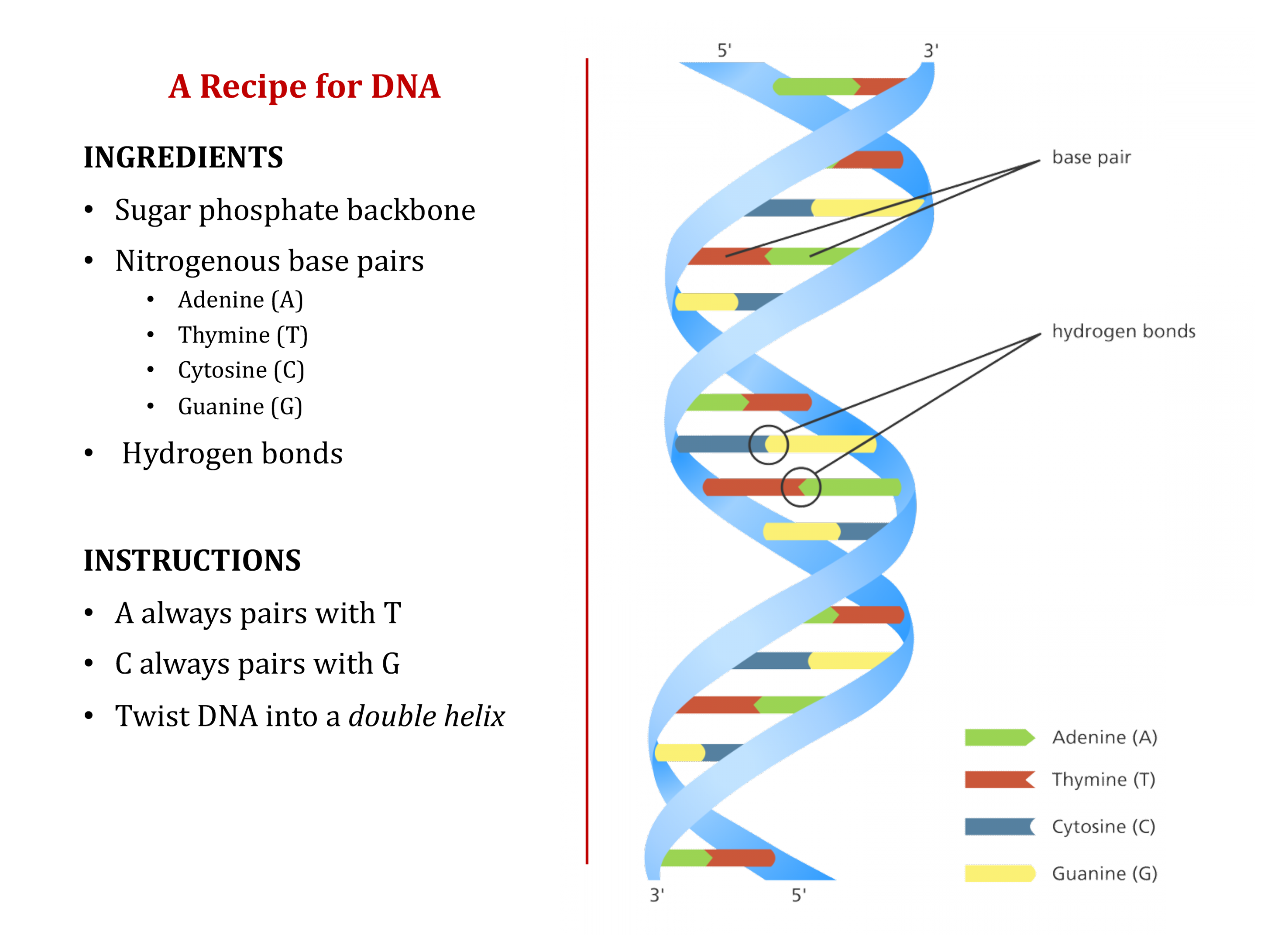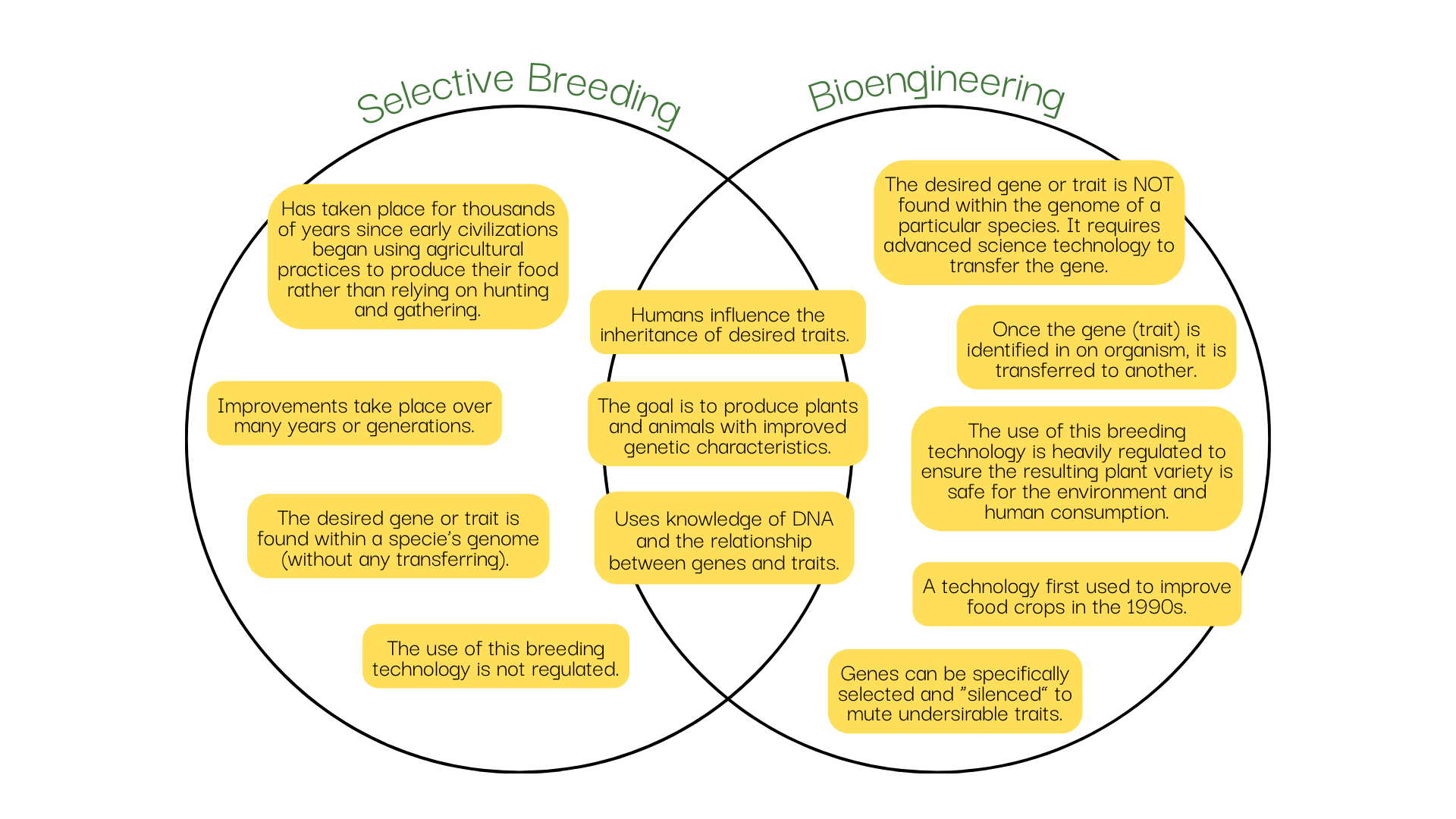A Recipe for Genetics: Selective Breeding and Bioengineering (Grades 6-8)
Students identify technologies that have changed the way humans affect the inheritance of desired traits in organisms; compare and contrast selective breeding methods to bioengineering techniques; and analyze data to determine the best solution for cultivating desired traits in organisms.

Background
Lesson Activities
Recommended Companion Resources
Credits
Author
Bekka Israelsen | Utah Agriculture in the Classroom
Acknowledgements
Activity 2 designed by Chrissy Dittmer from Iowa Agriculture in the Classroom
Sources
- Current GMO Crops | GMO Answers
- How Your Food Would Look If Not Genetically Modified Over Millennia | Genetic Literacy Project
- Crop Breeding | Crop Science Society of America
- About Norman Borlaug | The World Food Prize
- National Academies News Release
- U.S. Regulation of Genetically Modified Crops | Federation of American Scientists
- Dairy Farm | Colorado Mental Health Institute at Pueblo Museum
- How Wisconsin Dairy Raised Top Milk-Producing Cow | Dairy Herd Management
- How Bob Thompson's Holsteins Ended Up Across the Globe | North Country Public Radio
- Infographic Library | Beef. It's What's For Dinner.
- From Foraging to Farming | National Agriculture in the Classroom
- Frank Mitloehner: Cattle, Climate Change, and Methane Myth | Alltech
- Charting New York's Milky Way | Cornell CALS
- Sire Lineup | Select Sires Beef
- Artificial Selection: Breeding for Desirable Traits | ThoughtCo
- Agricultural Biotechnology Glossary | USDA
- GMO Crops, Animal Food, and Beyond | FDA
Standards
Indiana Content Area Standards
-
English Language Arts.Grade 6.RN.1
Read a variety of nonfiction within a range of complexity appropriate for grades 6-8. By the end of grade 6, students interact with texts proficiently and independently at the low end of the range and with scaffolding as needed at the high end of the range.
- Key Ideas and Textual Support.6.RN.2.1: Analyze what a text says explicitly as well as draw inferences from the text through citing textual evidence.
- Synthesis and Connection of Ideas.6.RN.4.2: Integrate information presented in different media or formats (e.g., visually, quantitatively, verbally) to demonstrate a coherent understanding of a topic or issue.
-
English Language Arts.Grade 6.RV.1
Acquire and use accurately grade-level appropriate general academic and content-specific words and phrases; gather vocabulary knowledge when considering a word or phrase important to comprehension or expression.
- Vocabulary Building.6.RV.2.1: Use context to determine or clarify the meaning of words and phrases.
-
English Language Arts.Grade 6.SL.1
Listen actively and adjust the use of spoken language (e.g., conventions, style, vocabulary) to communicate effectively with a variety of audiences and for different purposes.
- Comprehension.6.SL.3.1: Interpret information presented in diverse media and formats (e.g., visually, quantitatively, orally) and explain how it contributes to a topic, text, or issue under study.
- Comprehension.6.Sl.3.2: Delineate a speakers argument and specific claims, distinguishing claims that are supported by reasons and evidence from claims that are not
- Discussion and Collaboration.6.SL.2.2: Elaborate and reflect on ideas under discussion by identifying specific evidence from materials under study and other resources.
- Discussion and Collaboration.6.SL.2.4: Pose and respond to specific questions with elaboration and detail by making comments that contribute to the topic, text, or issue under discussion.
-
English Language Arts.Grade 7.RN.1
Read a variety of nonfiction within a range of complexity appropriate for grades 6-8. By the end of grade 7, students interact with texts proficiently and independently at the middle of the range and with scaffolding as needed for texts at the high end of the range.
- Key Ideas and Textual Support.7.RN.2.1: Analyze what a text says explicitly as well as draw inferences from the text through citing several pieces of textual evidence.
- Synthesis and Connection of Ideas.7.RN.4.2: Compare and contrast a print or digital text with an audio, video, or multimedia version of the text, analyzing each mediums portrayal of the subject (e.g., how the delivery of a speech affects the impact of the words).
-
English Language Arts.Grade 7.RV.1
Acquire and use accurately grade-appropriate general academic and content-specific words and phrases; gather vocabulary knowledge when considering a word or phrase important to comprehension or expression.
- Vocabulary Building.7.RV.2.1: Use context to determine or clarify the meaning of words and phrases.
-
English Language Arts.Grade 7.SL.1
Listen actively and adjust the use of spoken language (e.g., conventions, style, vocabulary) to communicate effectively with a variety of audiences and for different purposes.
- Comprehension.7.SL.3.1: Analyze the main ideas and supporting details presented in diverse media and formats (e.g., visually, quantitatively, orally) and explain how the ideas clarify a topic, text, or issue under study.
- Comprehension.7.SL.3.2: Delineate a speakers argument and specific claims, evaluating the soundness of the reasoning, relevance, and sufficiency of the evidence.
- Discussion and Collaboration.7.SL.2.1: Engage effectively in a range of collaborative discussions (e.g., one-on-one, in groups, and teacher-led) on grade- appropriate topics, texts, and issues, building on others ideas and expressing personal ideas clearly.
- Discussion and Collaboration.7.SL.2.2: Investigate and reflect on ideas under discussion by identifying specific evidence from materials under study and other resources.
- Discussion and Collaboration.7.SL.2.4: Pose questions that elicit elaboration and respond to others questions and comments with relevant observations and ideas that bring the discussion back on topic as needed.
-
English Language Arts.Grade 8.RN.1
Read a variety of nonfiction within a range of complexity appropriate for grades 6-8. By the end of grade 8, students interact with texts proficiently and independently.
- Key Ideas and Textual Support.8.RN.2.1: Analyze what a text says explicitly as well as draw inferences from the text through strong and supportive textual evidence.
- Synthesis and Connection of Ideas.8.RN.4.2: Evaluate the advantages and disadvantages of using different mediums (e.g., print or digital text, video, multimedia) to present a particular topic of idea.
-
English Language Arts.Grade 8.RV.1
Acquire and use accurately grade-appropriate general academic and content-specific words and phrases; gather vocabulary knowledge when considering a word or phrase important to comprehension or expression.
- Vocabulary Building.8.RV.2.1: Use context to determine or clarify the meaning of words and phrases.
-
English Language Arts.Grade 8.SL.1
Listen actively and adjust the use of spoken language (e.g., conventions, style, vocabulary) to communicate effectively with a variety of audiences and for different purposes.
- Comprehension.8.SL.3.1: Analyze the purpose of information presented in diverse media and formats (e.g., visually, quantitatively, orally) and evaluate the motives (e.g., social, commercial, political) behind its presentation.
- Comprehension.8.SL.3.2: Delineate a speakers argument and specific claims, evaluating the soundness of the reasoning and relevance and sufficiency of the evidence and identifying when irrelevant evidence is introduced.
- Discussion and Collaboration.8.SL.2.1: Engage effectively in a range of collaborative discussions (e.g., one-on-one, in groups, and teacher-led) on grade- appropriate topics, texts, and issues, building on others ideas and expressing personal ideas clearly.
- Discussion and Collaboration.8.SL.2.2: Examine, analyze, and reflect on ideas under discussion by identifying specific evidence from materials under study and other resources.
- Discussion and Collaboration.8.SL.2.4: Pose questions that connect the ideas of several speakers and respond to others questions and comments with relevant evidence, observations, and ideas.



